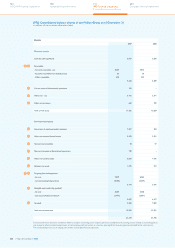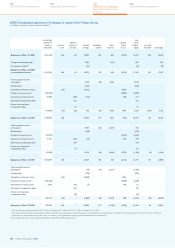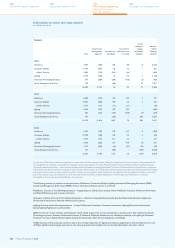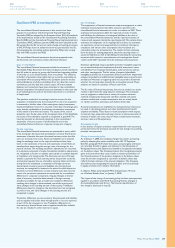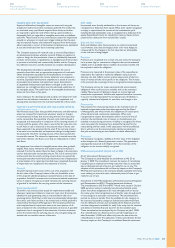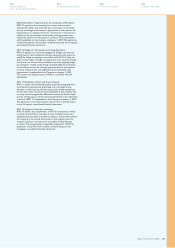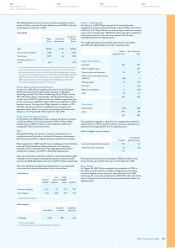Philips 2008 Annual Report Download - page 210
Download and view the complete annual report
Please find page 210 of the 2008 Philips annual report below. You can navigate through the pages in the report by either clicking on the pages listed below, or by using the keyword search tool below to find specific information within the annual report.
Reclassifications and revisions
Certain items previously reported under specific financial statement
captions have been reclassified to conform to the current year
presentation.
Prior-period amounts have been revised to adjust for certain
intercompany profit eliminations on inventories in Healthcare
related to prior years. These adjustments are not material to the
consolidated financial statements in any of the prior periods.
The table below outlines the impact of these adjustments:
in millions of euros unless otherwise stated 2006 2007
Decrease in income before taxes (3) (11)
Decrease in income tax expense 1 3
Decrease in net income (2) (8)
Decrease in net income per common
share in euros
- basic (0.00) (0.01)
- diluted (0.00) (0.01)
The effect on retained earnings as of December 31, 2005 is
a decrease of EUR 32 million.
Discontinued operations and non-current assets held for sale
Non-current assets (disposal groups comprising assets and liabilities)
that are expected to be recovered primarily through sale rather
than through continuing use are classified as held for sale.
A discontinued operation is a component of an entity that either
has been disposed of, or that is classified as held for sale, and (a)
represents a separate major line of business or geographical area
of operations; and (b) is a part of a single coordinated plan to dispose
of a separate major line of business or geographical area of operations;
or (c) is a subsidiary acquired exclusively with a view to resale.
Non-current assets held for sale and discontinued operations are
carried at the lower of carrying amount or fair value less costs to sell.
Any gain or loss from disposal of a business, together with the results
of these operations until the date of disposal, is reported separately
as discontinued operations. The financial information of discontinued
operations is excluded from the respective captions in the consolidated
financial statements and related notes for all years presented.
Cash flow statements
Cash flow statements are prepared using the indirect method. Cash
flows in foreign currencies have been translated into euros using the
weighted average rates of exchange for the periods involved. Cash
flows from derivative instruments that are accounted for as fair value
hedges or cash flow hedges are classified in the same category as the
cash flows from the hedged items. Cash flows from other derivative
instruments are classified consistent with the nature of the instrument.
Segments
Operating segments are components of the Company’s business
activities about which separate financial information is available that is
evaluated regularly by the chief operating decision maker (the Board
of Management of the Company). The Board of Management decides
how to allocate resources and assesses performance. Reportable
segments comprise: Healthcare, Consumer Lifestyle, Lighting, and
Television. Segment accounting policies are the same as the accounting
policies as applied to the Group.
Earnings per share
The Company presents basic and diluted earnings per share (EPS)
data for its common shares. Basic EPS is calculated by dividing the net
income attributable to shareholders of the Company by the weighted
average number of common shares outstanding during the period.
Diluted EPS is determined by adjusting the profit or loss attributable
to shareholders and the weighted average number of common shares
outstanding for the effects of all dilutive potential common shares,
which comprise convertible personnel debentures, restricted shares
and share options granted to employees.
Revenue recognition
Revenue for sale of goods is recognized when the significant risks and
rewards of ownership have been transferred to the buyer, recovery of
the consideration is probable, the associated costs and possible return
of the goods can be estimated reliably, there is no continuing involvement
with goods, and the amount of revenue can be measured reliably.
Transfer of risks and rewards varies depending on the individual
terms of the contract of sale. For consumer-type products in the
Sectors Lighting and Consumer Lifestyle, these criteria are generally
met at the time the product is shipped and delivered to the customer
and, depending on the delivery conditions, title and risk have passed
to the customer and acceptance of the product, when contractually
required, has been obtained, or, in cases where such acceptance is not
contractually required, when management has established that all
aforementioned conditions for revenue recognition have been met.
Examples of the above-mentioned delivery conditions are ‘Free on
Board point of delivery’ and ‘Costs, Insurance Paid point of delivery’,
where the point of delivery may be the shipping warehouse or any
other point of destination as agreed in the contract with the customer
and where title and risk in the goods pass to the customer.
Revenues of transactions that have separately identifiable components
are recognized based on their relative fair values. These transactions
mainly occur in the Healthcare sector and include arrangements that
require subsequent installation and training activities in order to become
operable for the customer. However, since payment for the equipment
is typically contingent upon the completion of the installation process,
revenue recognition is deferred until the installation has been completed
and the product is ready to be used by the customer in the way
contractually agreed.
Revenues are recorded net of sales taxes, customer discounts, rebates
and similar charges. For products for which a right of return exists
during a defined period, revenue recognition is determined based
on the historical pattern of actual returns, or in cases where such
information is not available, revenue recognition is postponed until
the return period has lapsed. Return policies are typically based on
customary return arrangements in local markets.
For products for which a residual value guarantee has been granted
or a buy-back arrangement has been concluded, revenue recognition
takes place in accordance with the requirements for lease accounting
of IAS 17 Leases. Shipping and handling costs billed to customers are
recognized as revenues. Expenses incurred for shipping and handling
costs of internal movements of goods are recorded as cost of sales.
Shipping and handling costs related to sales to third parties are recorded
as selling expenses and disclosed separately. Service revenue related
to repair and maintenance activities for goods sold is recognized
ratably over the service period or as services are rendered.
A provision for product warranty is made at the time of revenue
recognition and reflects the estimated costs of replacement and
free-of-charge services that will be incurred by the Company with
respect to the products. The customer has the option to purchase
such an extension, which is subsequently billed to the customer. Revenue
recognition occurs on a straight-line basis over the contract period.
Royalty income, which is generally earned based upon a percentage
of sales or a fixed amount per product sold, is recognized on an
accrual basis.
Government grants are recognized as income as qualified
expenditures are made, except for grants relating to purchases
of assets, which are deducted from the cost of the assets.
Employee benefit accounting
The net pension asset or liability recognized in the balance sheet in
respect of defined-benefit postemployment plans is the fair value of
plan assets less the present value of the projected defined-benefit
obligation at the balance sheet date, together with adjustments for
projected unrecognized past service costs. The projected defined-
benefit obligation is calculated annually by qualified actuaries using
the projected unit credit method. Recognized assets are limited to
the present value of any reductions in future contributions or any
future refunds, in accordance with IFRIC Interpretation 14 ‘The Limit
on a Defined Benefit Asset, Minimum Funding Requirements and
their Interaction’.
For the Company’s major plans, a full discount rate curve of high-quality
corporate bonds (Bloomberg AA Composite) is used to determine
the defined-benefit obligation whereas for the other plans, a single-
point discount rate is used based on the plan’s maturity. Plans in
countries without a deep corporate bond market use a discount rate
based on the local sovereign curve and the plan’s maturity.
Pension costs in respect of defined-benefit postemployment plans
primarily represent the increase of the actuarial present value of the
obligation for postemployment benefits based on employee service
during the year and the interest on this obligation in respect of
employee service in previous years, net of the expected return on
plan assets.
Philips Annual Report 2008210
180
Sustainability performance
244
Company financial statements
124
US GAAP financial statements
192
IFRS financial statements
Significant IFRS accounting policies


